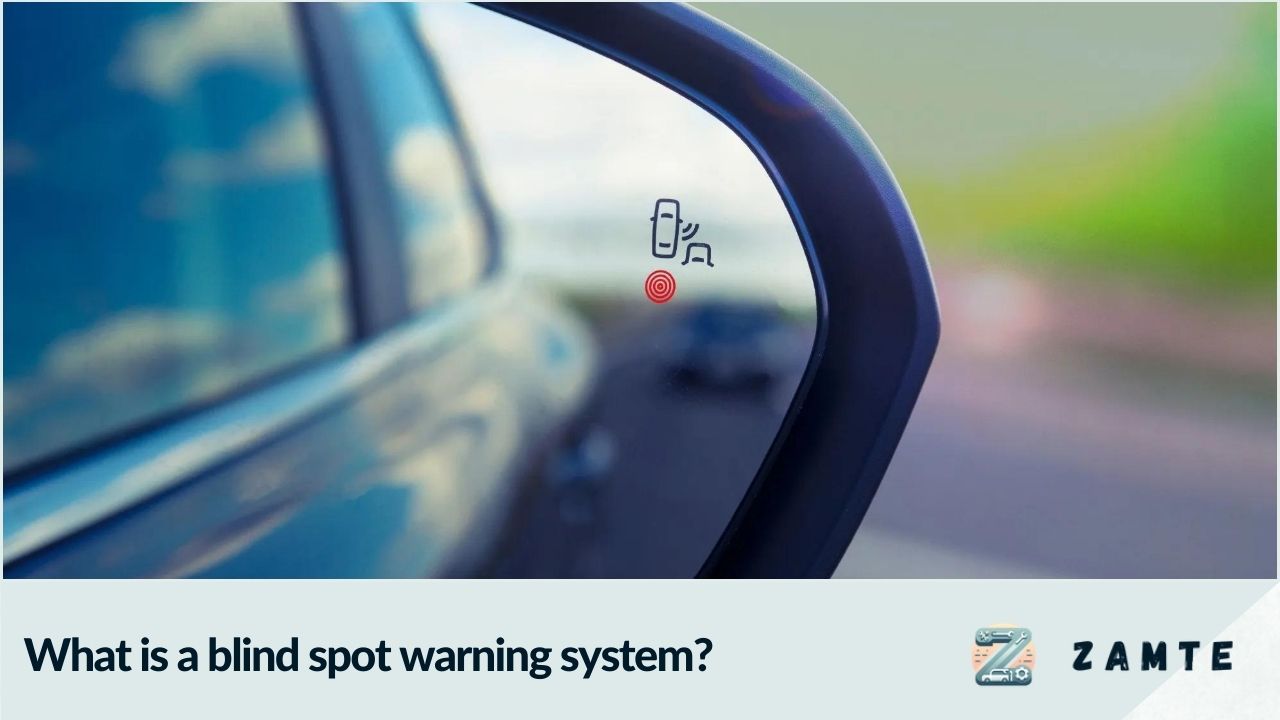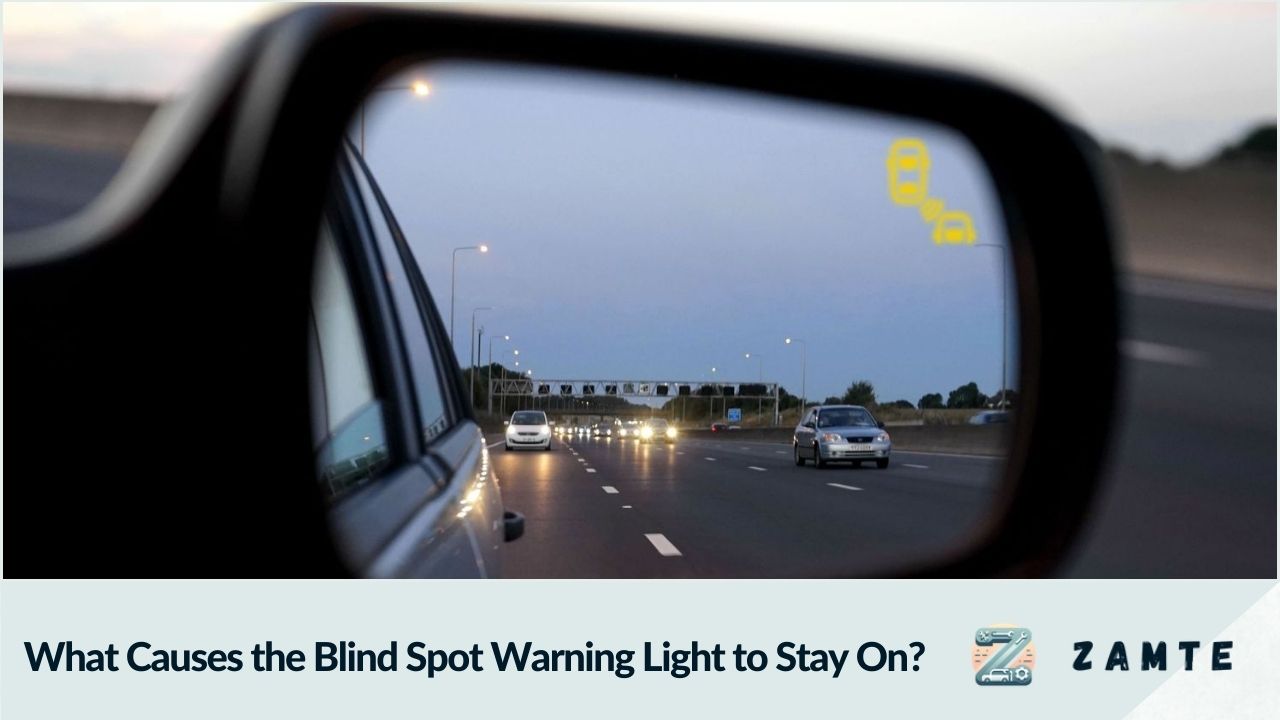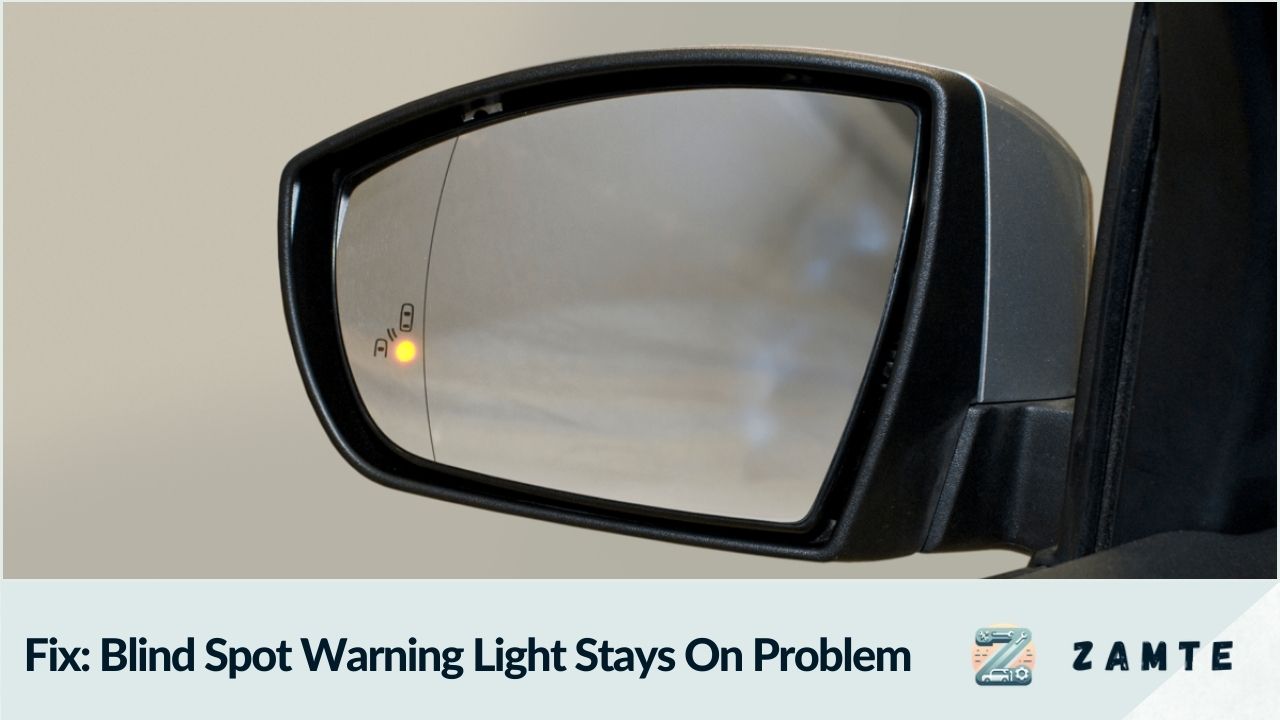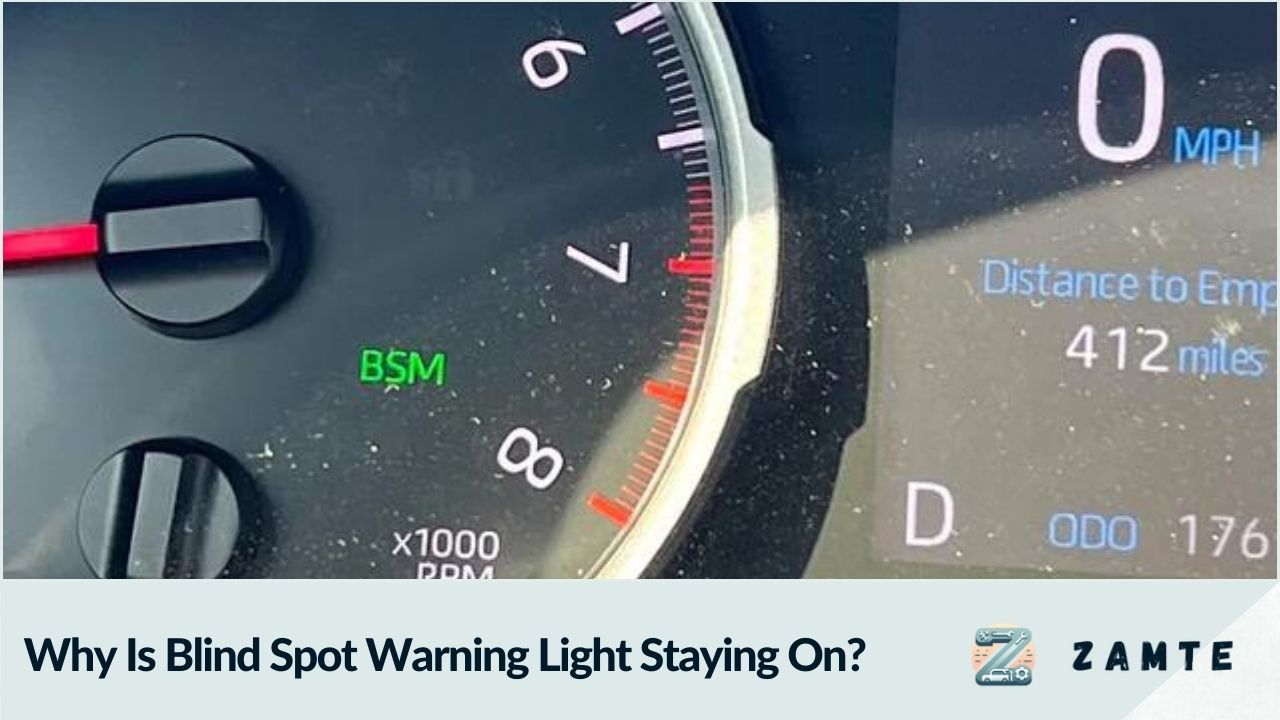Is your car's blind spot warning light always on? When this light turns on for a short time and is yellow, everything is working fine.
But, if the light doesn't turn off, it means there's something in the place you can't see well when driving. Be very careful when changing lanes or turning.
If the light keeps on, you should quickly go to a car repair place that can fix it.
We wrote a lot about the blind spot warning light to help you understand why it happens.
Keep reading to learn more about this problem.
For more details, check out our website, Zamte, where we discuss why your blind spot warning light stays on.
What is a blind spot warning system, and how does it work?
A Blind Spot Warning System is a car safety tool to help drivers see where they can't easily look. It lets drivers know about other cars or things in their blind spots, making driving safer.

This system uses sensors, like radar or cameras, around the car. These sensors watch the sides and back of the car, looking for other vehicles or objects that the driver can't see.
When another car enters your blind spot or moves up fast from behind, these sensors make the Blind Spot Warning System work. Then, the system tells the driver there's something in the blind spot.
The system shows warnings with lights on the side mirrors or inside the car. Some systems also make sounds to alert the driver.
Sensors send information to a computer in the car. This computer checks the data and turns on warning lights or sounds if there's danger in the blind spot. This way, the system helps avoid accidents by making drivers aware of what's around them.
What are the basic components of a Blind Spot Warning System?
A Blind Spot Warning System helps drivers by telling them when there's something in their blind spot, the area you can't see while driving. It uses a few main parts and steps to do this:
Main Parts:
- Sensors: These are the most important parts. They can be radar or cameras and are put on the sides or back of the car. They watch the lanes next to you and the blind spot.
- Electronic Control Unit (ECU): This is the system's brain. It gets information from the sensors and determines if something is in the blind spot.
- Warning Indicator: This is a light or symbol on the side mirrors or dashboard. It lights up to tell you there's something in your blind spot.
- Auditory Alert (optional): Some systems also make a sound to warn you, adding another way to let you know there's a potential danger.
Operations:
- Always Watching: The sensors monitor the lanes next to your car and the blind spot.
- Finding Objects: If another car enters your blind spot or quickly emerges from behind, the sensors notice it and send the information to the ECU.
- Understanding the Data: The ECU looks at the data from the sensors. It decides if the thing it sees is a risk.
- Giving a Warning: If there's something in the blind spot, the system turns on the warning indicator. This could be a light on your mirror or a signal on your dashboard.
- Making a Sound (if the system has this): Some systems also beep or make another sound to ensure you know something is in your blind spot.
- Time to Act: When you see the warning, you should look carefully to ensure it's safe before changing lanes or turning.
This system makes driving safer by helping you know about things you can't see.
What Causes the Blind Spot Warning Light to Stay On?
When the Blind Spot Warning Light doesn't turn off, it might be because of a few different problems with the Blind Spot Monitoring (BSM) system:

- Something Blocking the Sensors: Dirt, trash, or bad weather can block the sensors that check for cars or objects in your blind spot. If these sensors can't see well, they might think there's always something there, making the light stay on.
- Sensors Not Working Right: If the sensors are broken, have an electrical problem, or get hit and damaged, they might not work right. They could wrongly think there's something in your blind spot all the time, which keeps the light on.
- Computer Problems: Sometimes, the system's computer might have a glitch or bug that makes mistakes. This can make the warning light stay on, even when there's nothing in your blind spot.
- Wiring Issues: If the wires are broken, not connected right, or there's some electrical problem, it can mess up the whole system. This might keep the warning light shining because the sensors and computer aren't talking properly.
These are some common reasons why the Blind Spot Warning Light might stay on. The system is trying to tell you something is wrong and needs to be checked.
Can I Continue Driving with the Blind Spot Warning Light On?
When the Blind Spot Warning Light stays on all the time, it can make driving less safe in different ways:
- Less Attention: If the warning light is always on, drivers might get used to it and ignore it. This means they might not notice when there's something in their blind spot.
- Hard to Know Real Danger: With the light always on, it's tough for drivers to tell when there's an actual problem. They might think it's just another false alarm.
- More Accident Risk: If drivers stop paying attention to the warning light because it's always on, they might not be careful about checking their blind spots. This could lead to unsafe lane changes or missing real dangers.
- Distracting: A warning light that doesn't turn off can be distracting. It might make drivers worry or take their focus off driving safely.
- Doubting the System: If the Blind Spot Warning Light keeps lighting up for no reason, drivers might think the whole system doesn't work right. This could make them less confident in using it or other safety features.
- Ignoring Other Warnings: A constantly on warning light might make drivers pay less attention to other important alerts or lights in the car. This could mean missing other key safety warnings.
Overall, if the Blind Spot Warning Light stays on, it can make driving harder. It's important to check why it's happening and fix it to keep driving safely.
What measures can solve the problem of the Blind Spot Warning Light Staying On?
Fixing the problem of the Blind Spot Warning Light staying on usually includes a few steps to figure out and fix the main issue:
- Cleaning the Sensors: First, check and clean the sensors of the Blind Spot Monitoring (BSM) system. These sensors are on the side mirrors or the back bumper. Removing dirt or anything blocking them might stop the light from staying on.
- Fixing or Replacing Sensors: The sensors might be broken or damaged if cleaning doesn't work. They may need repairing or replacing to make sure they can spot objects correctly and turn off the warning light.
- Updating Software or Resetting: Sometimes, updating or resetting the system's software can fix bugs or glitches that keep the warning light on. This usually needs special tools or a visit to the car service.
- Checking Wires and Connections: Look at the wires and connections in the BSM system. Fix any bad connections or broken wires that might stop the system from working correctly.
- Getting Professional Help: If the problem keeps happening, it's a good idea to ask for help from a professional who knows much about car electronics. They can check the system carefully, find out what's wrong, and fix it.
- Calibrating the System: The Blind Spot Monitoring system might need to be set up again to ensure the sensors work correctly. Proper setup can help the system read situations correctly and stop the warning light from always being on.
Doing these steps can help fix the problem and make the Blind Spot Warning System work right again, keeping driving safe.
How to calibrate the Blind Spot Sensor?
Calibrating a Blind Spot Sensor ensures it's pointing in the right direction and working right. Here's a basic way to do it:
- Find How to Calibrate: Look in your car's manual or the maker's instructions. Different cars have different ways to calibrate their sensors.
- Get Ready: Park your car where it's flat and open, with nothing around that could mess up the calibration.
- Start the Car: Turn on the ignition to get the Blind Spot Monitoring (BSM) system ready. You should turn the system on from your dashboard or a screen in your car.
- Find Calibration Settings: Some cars have a special button or menu on the dashboard or a screen for sensor calibration. Use these to start calibrating.
- Follow Instructions: If there are steps on the screen, do what they say. This might include turning the steering wheel a certain way or starting a calibration sequence.
- Adjust the Sensors: You might need to move the sensors manually. Make sure to follow the car maker's directions carefully.
- Finish Calibrating: After doing the steps or adjustments, follow any more instructions until the calibration is done.
- Test Drive: Drive around to check that the sensors are working properly. The warning light shouldn't stay on if everything's set up right. Look for any signs on your dashboard that everything's calibrated.
This is a general guide, so check your car's instructions to get it right.
How do we fix the Blind Spot Warning Light Stays On problem?
If your Blind Spot Warning Light won't turn off, here's how you can try to fix it:

- Check the Sensors: Look at the sensors for the Blind Spot Monitoring (BSM) system. Please make sure they're clean and nothing's blocking them.
- Clean the Sensors: If the sensors are dirty or blocked, gently clean them with a soft cloth and safe cleaning products. This helps them see clearly.
- Run a Diagnostic Test: Use special tools for cars to check for any error messages from the BSM system.
- Update Software or Reset: Updating or resetting the system's software might fix glitches. Make sure to use the right tools or services for your car model.
- Check Wires and Connections: Look over the wires and connections for the BSM system. Ensure everything's connected right and there's no damage to the cables.
- Get Help from a Pro: If the problem still isn't fixed, or if it's hard to figure out what's wrong, it's best to ask for help from someone who knows much about car electronics.
- Look in the Manual: Your car's manual or the maker's instructions might have specific tips for fixing problems with the BSM system.
- Be Safe: Always follow safety advice and work on your car in a safe spot. Make sure you're doing everything safely when trying to fix the problem.
These steps can help you find and fix why your Blind Spot Warning Light stays on.
Can software updates fix the Blind Spot Warning Light Stays On issue?
Yes, software updates can sometimes fix the problem of the Blind Spot Warning Light staying on. Car makers often release software updates to fix bugs or improve safety features, including the Blind Spot Monitoring (BSM) system.
Here's how a software update can help:
- Fixing Bugs: Updates can fix bugs in the system that might make the warning light stay on when it shouldn't.
- Better Algorithms or Calibration: Sometimes, updates make the system smarter or adjust how it's set up. This can make the sensors more accurate and less likely to think there's something wrong in your blind spot.
- System Stability: An update can make the BSM system work better and more reliably. This might help prevent false alarms that cause the warning light to turn on for no reason.
But it's good to remember that software updates can't fix everything. Suppose the warning light stays on because of a broken sensor, damage, or a wiring problem. In that case, more than just updating the software will be needed to fix the issue.
Final Words
Knowing how the Blind Spot Warning System works helps keep you safe on the road. If the warning light keeps turning on, checking and fixing any problems is important. Sometimes, you can do it yourself, but often, you need professional help. Keeping the sensors clean, updating software, and safe driving can help prevent problems. Quick action is key to making sure this important safety feature works right.

